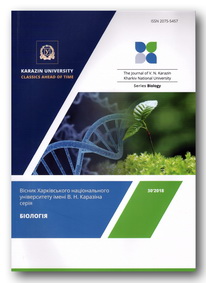Біорізноманіття та структура спільнот ґрунтових інфузорій Талишських лісів південно-східного Азербайджану
Анотація
У статті наведені дані про фауну ґрунтових інфузорій південно-східного Азербайджану. В результаті досліджень, проведених в 2017–2019 роках, було відзначено 65 видів ґрунтових інфузорій, що належать до 33 родин. Найбільше видове різноманіття інфузорій-педобіонтів спостерігалося в лісових ґрунтах Масалли і Ленкоран. Однак найменша різноманітність видів відзначена в Астаринському регіоні. Найбільше видове різноманіття встановлено для сімейства Colpodidae, з представників якого було відзначено 7 видів. Чотири з них належать до педобіонтного роду Colpoda. Майже всі представники цього роду є типово ґрунтовими мешканцями і еврибіонтами з широкою екологічною пластичністю. Крім цього, були відзначені також два види представників роду Tillina, також мешканців ґрунтів, але які зустрічаються часом і в прісних водоймах. Потрібно відзначити, що особливі природно-кліматичні умови Ленкоранської природної області наклали свій відбиток на закономірності поширення інфузорій в гірсько-лісових ґрунтах. Акумуляція інфузорій в лісових ґрунтах навесні спостерігається в верхньому горизонті ґрунтової підстилки шару 5 см, влітку в зв'язку зі зменшенням вологості у верхніх шарах спостерігається міграція інфузорій-педобіонтів в глибші шари (10–15 см), а восени із збільшенням опадів і вологості в верхніх ґрунтових горизонтах основна маса ґрунтових інфузорій знову локалізується в лісовій підстилці і в верхньому шарі ґрунтів. Слід також відзначити і ще один специфічний комплекс інфузорій в лісових ґрунтах південно-східного Азербайджану. Ранньою весною і восени, при максимальній вологості лісового ґрунту ми часто відзначали інфузорій, які зазвичай мешкають в прісних водах. Серед них можна відзначити представників таких родів, як Zosterodasys, Nassula, Aspidisca, Blepharisma, Frontonia, Urotricha та ін. Був також обчислений індекс подібності спільнот ґрунтових інфузорій в Талишських лісах Ленкоранського природного району. У дослідженні зроблено спробу порівняти відмінності у спільнотах інфузорій у п'яти різних регіонах південно-східної частині Азербайджану. Аналіз за Бреєм-Кертисом показав, що існує три кластери подібності фауни інфузорій різних досліджених районів південно-східного Азербайджану. Між фаунами високогірних і рівнинних районів спостерігалося менша подібність (52,15–69,00 %).
Завантаження
Посилання
Alekperov I.Kh. New modification of impregnation ciliates kinetom by silver proteinate // Zoologicheskii Zhurnal (Zoological Journal). – 1992. – No.2. – P. 130–133. (in Russian)
Alekperov I.Kh. An atlas of freeliving ciliates (Classes Kinetofragminophora, Colpodea, Olygohymenophora, Polyhymenophora). – Baku: “Borchali” Publ., 2005. – 310p. (in Russian)
Chatton E., Lwoff A. Impregnation, par diffusion argentique, de lʹ infraciliature des Cilies marins et d’eau douce, apres fixation cytologique et sans dessication // C. R. Soc. Biol. Paris. – 1930. – Vol.104. – P. 834–836.
Christoffersen K., González J.M. An approach to measure ciliate grazing on living heterotrophic nanoflagellates // Hydrobiologia. – 2003. – Vol.491. – P. 159–166.
Ekelund F., Rønn R. Notes on protozoa in agricultural soil with emphasis on heterotrophic flagellates and naked amoebae and their ecology // FEMS Microbiology Reviews. – 1994. – Vol. 15, no.4. – P. 321–353.
Foissner W. Soil protozoa: fundamental problems, ecological significance, adaptations in ciliates and testaceans, bioindicators, and guide to the literature // Progress in Protistology. – 1987. – Vol.2. – P. 69–212.
Foissner W. Estimating the species richness of soil protozoa using the non-flooded Petri dish method // In: J.J.Lee and A.T.Soldo (eds.) Protocols in Protozoology. – Allen Press, Lawrence, Kansas. 1992. – P. B10.1–10.2.
Foissner W. Protozoa as bioindicators in agroecosystems, with emphasis on farming practices, biocides, and biodiversity // Agriculture, Ecosystems and Environment. – 1997. – Vol.63, no.2–3. – P. 93–103.
Foissner W. Soil protozoa as bioindicators: pros and cons, methods, diversity, representative examples // Agriculture, Ecosystems and Environment. – 1999. – Vol.74, no.1–3. – P. 95–112.
Janssen M.P., Heijmans G.J. Dynamics and stratification of protozoa in the organic layer of a Scots pine forest // Biology and Fertility of Soils. – 1998. – Vol.26, no.4. – P. 285–292.
Jing Li, Qingyu Liao, Mei Li et al. Community structure and biodiversity of soil ciliates at Dongzhaigang mangrove forest in Hainan Island, China // Applied and Environmental Soil Science. – 2010. – Vol.2010. – Article ID 103819.
Автори залишають за собою право на авторство своєї роботи та передають журналу право першої її публікації на умовах ліцензії Creative Commons Attribution License 4.0 International (CC BY 4.0), яка дозволяє іншим особам вільно розповсюджувати опубліковану роботу з обов'язковим посиланням на авторів оригінальної роботи.




